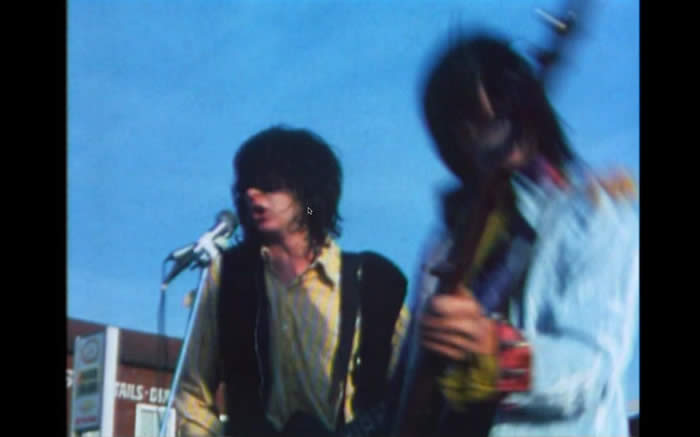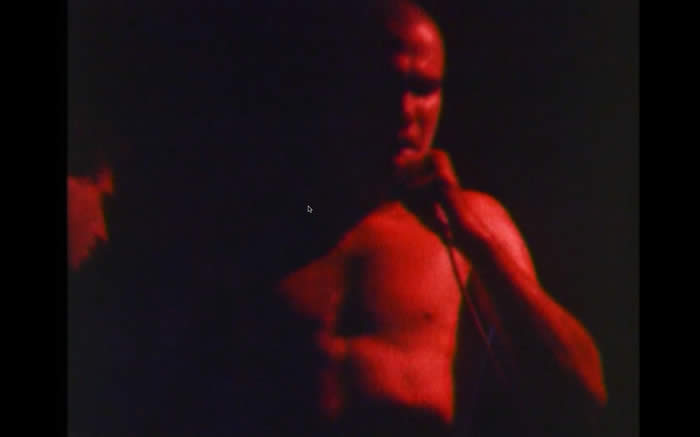Thurston Moore on The Slog
L.A. TV cop shows like CHIPS and Quincy were featuring episodes where punk rockers were merchants of mayhem. The absurdity of punk's public persona was not lost to a lot of young smart kids who saw punk as a means of instant expression. For those living in Santa Monica, the fact that the Germs were bonafide Santa Monica / WLA residents was another fact not lost. The Hollywood punk scene recoiled at the influx of SoCal kids shaving their heads, cranking amps to play speed skank hardcore and instigating a very virgin male slam pit all in the name of punk rock. The Santa Monica early 80's kids seemed caught in between the intellectual Hollyweird world and the bonehead Huntington Beach brigade. And they were duly informed by both. Certainly Dave Markey was. Dave, Jordan and Jennifer Schwartz and Mike Geek and all their pals from SAMO High and UNI High. They were into Black Flag for the whole package not just the hardcore slam - they recognized the loaded expression of Raymond Pettibon's art and the strange and excited intelligence of Chuck Dukowski. Dave had an eye for the radical environment of L.A. punk. He started a fanzine called We Got Power, released compilations of new hardcore bands from across the USA, played drums in Sin 34, and shot Super 8 film whenever he could afford the time and money to do so. Dave had made some punk-psychedelic films as a kid that were pre-punk and post-psyche and therefore unique in a way that only a creative goodtime visionary can execute. His response to the perversity of social reality and the inherent pressure to conform was to mirror the frustrated hypocrisy of it all with liberated lunacy. The Slog Movie at once captures the substrata of L.A. 1st generation hardcore by hanging out with it in the backyards and empty matinee gigs it crashes around in. As there is only so much fun in tracking the brattitude of a band like Symbol Six, Dave creates vignettes of satirical attack on the inanity of lame rock culture like Ted Nugent. And booking the confounding and completely rocking Red Cross at an outdoor show on the Santa Monica Pier is a moment where real creative punk and poser punk is separated. SST Records refuses to have Dave include Black Flag's music or images of the label boss in this film which is disconcerting but kinda fucked up and cool not unlike all the fucked up and cool shit that was going down in L.A. in the Reagan 80's. Reagan's dopey call to conservatism ignited pissed off behavior from straight-ahead hardcore kids like Wasted Youth as well as older punks from the nothing's -sacred budweiser and blowjob humor of Fear to the supergroup punk of Circle Jerks and TSOL. These seminal groups, along with the Cheifs and Sin 34 themselves, are in The Slog Movie. It was Black Flag who really exploded a lot of thought and action into the scene at this time but it's as interesting to see the footage Dave has shot of Circle One. Circle One, particularly it's singer John Macias, took societal pressure as an infuriating threat. They processed it on a more basic hardcore level eradicating any visionary aspect Black Flag may have been mining. Their existence on this scene was legend and The Slog Movie captures it from the pit. (Macias, impaired by psycho-biologic issues, would later become a hardcore christian street preacher. In 1990, in a fit of rampage due to neglect of medication, Santa Monica police shot him dead.) The
bottled
up violence punk projected was offset by the camaraderie and general
funtime running through the scene. Dave not only gets
this w/ his camera but he lives
it as well. Hanging out at Oki-Dog after the punk gig and
then having the scene dispersed by cops was a life lesson for those
early 80s kids
and one that defined a lot of outlooks to the future. It was the real
underground that would ultimately manifest itself into a post-Nirvana
punk commercialism. Dave would later shoot feature length underground
classics like Lovedolls
Superstar and 1991: The Year Punk Broke which
featured Nirvana at their
pre-fame best. He continues to do work spiked by the vision of his
early punk rock days but without the bullshit society sell out. - Thurston Moore
|

